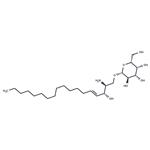Description
Galactosylsphingosine is a bioactive sphingolipid. It potentiates LPS-induced production of inflammatory cytokines, decreases the mitochondrial membrane potential, and induces cell death in mouse astrocytes, effects that can be reversed by the sphingosine-1-phosphate receptor agonist FTY720 phosphate . Galactosylsphingosine (0.1 and 1 μM) induces demyelination of mouse cerebellar slices. It inhibits PDGF-induced translocation of PKC to the cell surface and induces apoptosis in MO3.13 oligodendrocytes. Galactosylsphingosine (10 and 15 μM) inhibits gene transcription mediated by peroxisome proliferator-activated receptor α (PPARα) in reporter assays using C6 glial cells. Levels of galactosylsphingosine are increased in postmortem brain from patients with Krabbe disease, a lysosomal storage disorder characterized by a β-galactosylceramidase deficiency.[Matreya, LLC. Catalog No. 1305]
Uses
Psychosine is a cationic lysosphingolipid that displays neuroprotective effects against quisqualate.
Definition
ChEBI: A glycosylsphingoid consisting of sphingosine having a beta-D-galactosyl residue attached at the 1-position.
General Description
Galactosyl(β) Sphingosine (d18:1) is a substrate for the enzyme endoglycoceramidase I (EGCase I). It has sphingosine backbone with galactose attached to it and is a brain glycospingolipid.
Biochem/physiol Actions
Galatosylsphingosine or psychosine is a cytotoxic lipid which accumulates in oligodendrocytes due to dysfunctional lysosomal enzyme galactosylceramidase and is implicated in globoid cell leukodystrophy. Psychosine accumulation induces demyelination, astrocyte dysfunction and pro-inflammatory cytokine release in Krabbe disease.
Enzyme inhibitor
This cationic brain lysosphingolipid (FWfree-base = 461.64 g/mol; CAS 2238- 90-6), also known as 1-O-b-D-galactosylsphingosine, inhibits metabotropic a1-adrenergic receptor signaling-induced phospholipase C activation in rat brain astrocytes. Psychosine also exerts protective effects against quisqualate, suggesting it may be useful in prophylaxis of neurodegenerative disorders arising from over-stimulation of hippocampal Group 1 metabolotropic glutamate receptor, or mGluR. Psychosine is the product of the reaction catalyzed by sphingosine b-galactosyltransferase and is the substrate for psychosine sulfotransferase and galactosylceramidase. Target(s): cerebroside-sulfatase, or arylsulfatase A; cytochrome c oxidase; cytokinesis; electron transport; galactosylgalactosylglucosylceramidase; glucocerebrosidase, lysosome; b-glucosidase; phosphorylase kinase; protein kinase C (11- 14); protein-tyrosine sulfotransferase; and sphingomyelinase.




